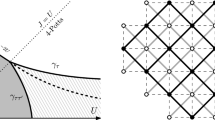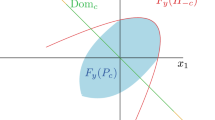Abstract
We extend some relations between percolation and the dependence of Gibbs states on boundary conditions known for Ising ferromagnets to other systems and investigate their general validity: percolation is defined in terms of the agreement of a configuration with one of the ground states of the system. This extension is studied via examples and counterexamples, including the antiferromagnetic Ising and hard-core models on bipartite lattices, Potts models, and many-layered Ising and continuum Widom-Rowlinson models. In particular our results on the hard square lattice model make rigorous observations made by Hu and Mak on the basis of computer simulations. Moreover, we observe that the (naturally defined) clusters of the Widom-Rowlinson model play (for the WR model itself) the same role that the clusters of the Fortuin-Kasteleyn measure play for the ferromagnetic Potts models. The phase transition and percolation in this system can be mapped into the corresponding liquid-vapor transition of a one-component fluid.
Similar content being viewed by others
References
M. Aizenman, J. Bricmont, and J. L. Lebowitz, Percolation of minority spins in high dimensional Ising models,J. Stat. Phys. 49:859–865.
M. Aizenman, J. T. Chayes, L. Chayes, and C. M. Newman, Discontinuity of the magnetization in one-dimensional 1/|x−y|2 Ising and Potts models,J. Stat. Phys. 50:1–40 (1988).
R. J. Baxter, Magnetization discontinuity of the two-dimensional Potts model,J. Phys. A 15:3329–3340 (1982).
J. van den Berg, A uniqueness condition for Gibbs measures, with application to the 2-dimensional Ising antiferromagnet,Commun. Math. Phys. 152:161–166 (1993).
J. van den Berg and J. E. Steif, On the hard-core lattice gas model, percolation, and certain log networks,Stoch. Proc. Appl. 49:179–197 (1994).
J. van den Berg and C. Maes, Disagreement percolation in the study of Markov fields,Ann. Prob., to appear.
J. Bricmont, J. L. Lebowitz, and C. Maes, Percolation in strongly correlated systems: The mass less Gaussian field,J. Stat. Phys. 48:1249–1268 (1987).
J. Bricmont and J. Slawny, First order phase transition and perturbation theory, inLecture Notes in Physics, Vol 257, T. C. Dorlas et al., eds. (Springer, Berlin, 1985), pp. 10–51.
M. Cassandro, G. Gallavotti, J. L. Lebowitz, and J. L. Monroe, Existence and uniqueness of equilibrium states for some spin and continuum systems,Commun. Math. Phys. 32:153–165 (1973).
A. Coniglio, C. R. Nappi, F. Peruggi, and L. Russo, Percolation and phase transitions in the Ising model,Commun. Math. Phys. 51:315–323 (1976).
R. L. Dobrushin, The problem of uniqueness of a Gibbsian random field and the problem of phase transition,Funct. Anal. Appl. 2:302–312 (1968).
R. L. Dobrushin, J. Kolafa, and S. B. Shlosman, Phase diagram of the two-dimensional Ising antiferromagnet (computer-assisted proof),Commun. Math. Phys. 102:89–103 (1985).
C. M. Fortuin and P. W. Kasteleyn, On the random cluster model. I. Introduction and relation to other models,Physica 57:536–564 (1972).
C. M. Fortuin, J. Ginibre, and P. W. Kasteleyn, Correlation inequalities on some partially ordered sets,Commun. Math. Phys. 22:89–103 (1971).
A. Gandolfi, M. Keane, and L. Russo, On the uniqueness of the infinite occupied cluster in dependent two-dimensional site percolation,Ann. Prob. 16:1147–11157 (1988).
H.-O. Georgii,Gibbs Measures and Phase Transitions (de Gruyter, Berlin, 1988).
G. R. Grimmett, The random cluster model, inProbability, Statistics and Optimisation, F. P. Kelly, ed. (Wiley, Chichester, 1994), pp. 49–63.
G. R. Grimmett, The stochastic random-cluster process and the uniqueness of random-cluster measures, Cambridge Stat. Lab. Res. Rep.98-8 (1994).
Ole J. Heilmann, The use of reflection as symmetry operation in connection with Peierls' argument,Commun. Math. Phys. 36:91–114 (1974).
Chin-Kun Hu and Kit-Sing Mak, Percolation and phase transitions of hard-core particles on lattices: Monte Carlo approach,Phys. Rev. B 39:2948–2951 (1989).
Chin-Kun Hu and Kit-Sing Mak, Percolation and phase transitions of hard-core particles on lattices with pair interactions,Phys. Rev. B 42:965–968 (1990).
D. Klein and W. S. Yang, Absence of first order phase transitions for antiferromagnetic systems,J. Stat. Phys. 70:1391–1400 (1993).
J. L. Lebowitz and G. Gallavotti, Phase transitions in binary lattice gases,J. Math. Phys. 12:1129–1133 (1971).
J. L. Lebowitz and A. Martin-Löf, On the uniqueness of the equilibrium State for Ising spin systems,Commun. Math. Phys. 25:276–282 (1972).
J. L. Lebowitz and J. L. Monroe, Inequalities for higher order Ising spins and for continuum fluids,Commun. Math. Phys. 28:301–311 (1972).
S. A. Molchanov and A. K. Stepanov, Percolation in random fields I,Theor. Math. Phys. 55:478 (1983).
S. A. Pirogov and Ya. G. Sinai, Phase diagrams for classical lattice systems,Theor. Math. Phys. 25:1185–1192 (1976).
C. Preston,Random Fields (Springer-Verlag., Berlin, 1976).
D. Ruelle, Existence of a phase transition in a continuous classical system,Phys. Rev. Lett. 27:1040 (1971).
L. Russo, The infinite cluster method in the two-dimensional Ising model,Commun. Math. Phys. 67:251 (1979).
B. Simon,The Statistical Mechanics of Lattice Gases, Vol. 1 (Princeton University Press, Princeton, New Jersey, 1993).
Ya. G. Sinai,Theory of Phase Transitions: Rigorous Results (Pergamon Press, Oxford, 1982).
J. Slawny, Low temperature properties of classical lattice systems: Phase transitions and phase diagrams, inPhase Transitions and Critical Phenomena, Vol. 5, C. Domb and J. L. Lebowitz, eds. (Academic Press, New York, 1986).
J. C. Wheeler and B. Widom, Phase equilibrium and critical behavior in a two-component Behte-lattice gas or three-component Bethe-lattice solution,J. Chem. Phys. 52:5334–5343 (1970).
B. Widom and J. S. Rowlinson, New model for the study of liquid-vapor phase transitions,J. Chem. Phys. 52:1670 (1970).
M. Zahradník, An alternate version of Pirogov-Sinai theory,Commun. Math. Phys. 93:559–581 (1984).
Author information
Authors and Affiliations
Rights and permissions
About this article
Cite this article
Giacomin, G., Lebowitz, J.L. & Maes, C. Agreement percolation and phase coexistence in some Gibbs systems. J Stat Phys 80, 1379–1403 (1995). https://doi.org/10.1007/BF02179875
Received:
Accepted:
Issue Date:
DOI: https://doi.org/10.1007/BF02179875




